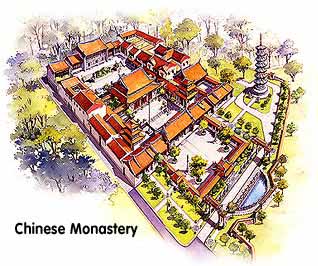
![]()
Buddhism teachings focuses on cultivation of mind with Ďemptinessí (to be detailed). This is the fundamental of Buddhism in fact. Somehow or rather from my point of view, Chinese Buddhist temples built traditionally out of mythology effects didnít portrays such Buddhist philosophy. Rather the temple seeks to be in a mythological fashion that seems to be close to devas more than the Buddha. (to be detailed)

The question is rather:
a. mythological represents meaning in these temples, yet can Chinese
Buddhist templeís essence still have meaning but with less traditional
elements thru the architectural process? more to contemporary?
b. Can Buddhism teachings and philosophies (to be precise
Ďemptinessí) translated into architecture? E.g. ancient temples in
India in ancient times where itís architecture is meaningful to itís
teachings.
Case study includes Water temple by Tadao Ando. How did the Buddha preach
during His reign.
The function of a temple is so narrow nowadays that many different kind of
temples evolved and so too the organization of Buddhist disciples. At a
brief view there are still temples that follow the traditional Chinese
halls system which itís architecture is still very traditional. These
are mostly temples of reputations built before the 50ís.
Secondly , new temples are also built but focused less on traditional
styles of temples and it is more functional with lesser detailing and of
course less meanings (from the point of view of Chinese culture). Third, a
newly evolved style of Chinese temples built on shop houses which aside
from offering and some community building holds no meanings at all. ( from
my point of view).
Temples are basically open to public everyday but has itís peak of
visitors at festivals. So the fundamental question to the temple is :
a. Apart from building a temple that gives offering and closer to Buddha,
what other activity can be introduced to the temple, such as education,
community center, culture tourism, center of cultivation, etc. to have the
temple function to itís optimum?
![]() This
is a thesis website by ressox studio.
This
is a thesis website by ressox studio.